As Fentanyl Overdoses Soar, LA City Crews Toss State-Funded Narcan from Encampments
“After sweeps, late at night when there’s no providers here, when there’s no one to give the Narcan to people, people are running up and down the street screaming, begging for Narcan.”
Jack Ross
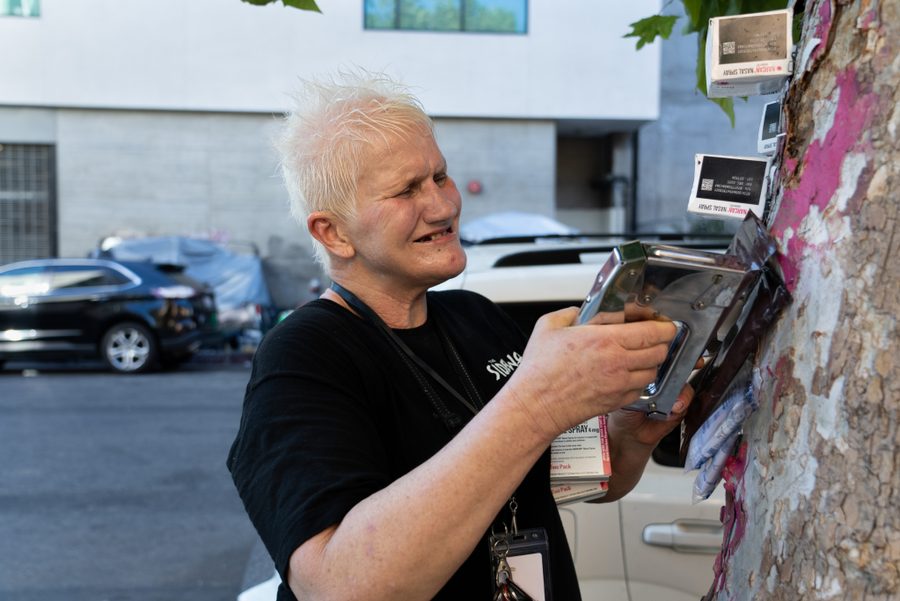
Virginia Reilly staples Narcan to a tree on Wall Street in Los Angeles, where she used to live in a tent. Jack Ross
Virginia Reilly is tricycling through Skid Row, in Los Angeles, wearing a shirt that says “NEVER USE ALONE,” nailing boxes of Narcan to trees with a staple gun.
Her dog, Ruby Reversal — as in “overdose reversal” — rides behind her in a wire basket; behind the dog, Reilly tows a wagon full of clean socks, cottons, sterilized needles, medicinal cannabis gummies and boxes and boxes of naloxone (Narcan is a brand of naloxone), a medicine that reverses nine out of 10 opioid overdoses.
“Hey sugar!” Reilly exclaims when her former neighbors emerge from their tents. She’s on Wall Street in Skid Row, a 4-square-mile area of downtown Los Angeles where about 2,700 people are estimated to live on the street.
Reilly says she uses drugs herself and lights up a pipe in the middle of her rounds, offering that she is best positioned to save the lives of her friends and former neighbors who are dying of drug overdoses at astonishing rates — largely because of fentanyl, a synthetic opioid 50 times stronger than heroin.
More than 2,200 unhoused people died in Los Angeles County in 2021 (the most recent year with complete data), and overdoses were responsible for more than a third of the deaths in 2020 and 2021. In ZIP codes encompassing Skid Row, fatal overdoses have increased by more than 1,000% since 2017 — with fentanyl involved in more than 70% of those deaths. Nationally, overdoses increased by roughly 53% during that same period, according to the Centers for Disease Control and Prevention.
“My friend was laying there on the asphalt with plastic over his face,” Reilly says when asked why she started nailing Narcan to trees. “We didn’t know where to get any Narcan. So we made a little memorial altar for him. And I made a little pink bag of Narcan and nailed it to [a nearby tree].”
“I thought that’s what I ought to do,” Reilly says, “make little bags and nail ‘em someplace people can get to it.”
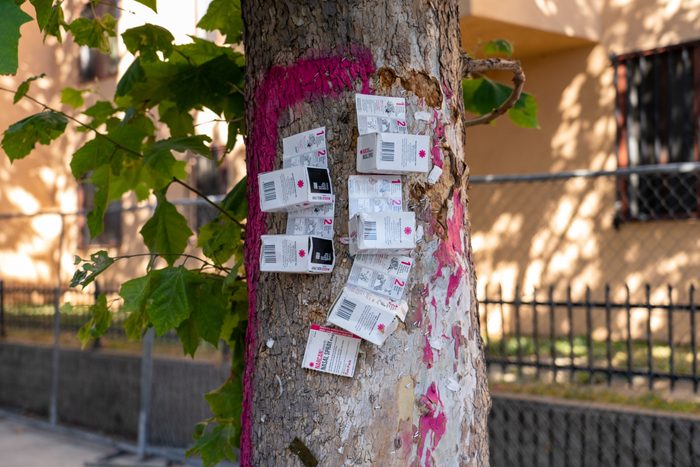
Reilly and other staff and volunteers with a harm-reduction nonprofit called The Sidewalk Project have since nailed naloxone to trees every week in Skid Row. They call the program the Tree of Life. Executive director Soma Snakeoil says the practice helps ensure the lifesaving drug gets distributed well and is easily accessible to those who need it.
But there’s another crucial reason they say they nail naloxone to trees: It increases the chances that the medicine will not be destroyed or taken when crews clear (or sweep) encampments. Something that, according to interviews with unhoused residents and harm-reduction groups in Los Angeles, is apparently happening with alarming frequency.
“After sweeps, late at night when there’s no providers here, when there’s no one to give the Narcan to people, people are running up and down the street screaming, begging for Narcan,” Snakeoil says.
Amanda Cowan, executive director of the Los Angeles Community Health Project (CHPLA), says unhoused people complain to her staff that they lose naloxone in sweeps “every day, every day. Because we do routes every day.”
Dozens of encampments are swept every weekday in Los Angeles, according to records produced by the Bureau of Sanitation. Cowan says her staff reports that about 70% of the naloxone her group distributes is “trashed” in the relentless sweeps. That number is based on follow-up conversations they conduct with the unhoused people they give the overdose medicine to when they resupply their naloxone.
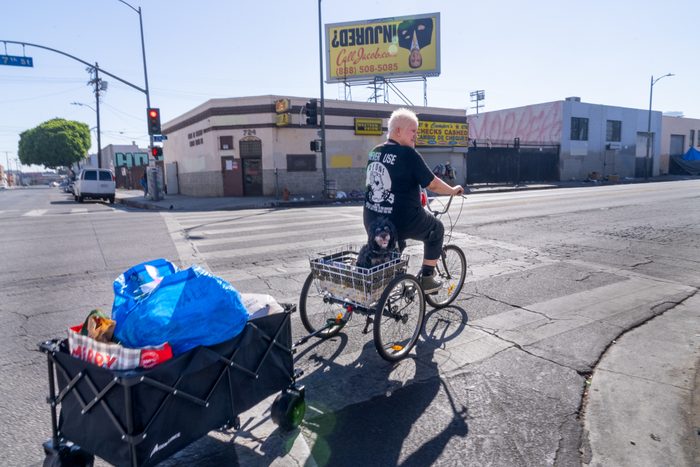
This underscores a profound contradiction in California’s response to its opioid and overdose crises. If the state is spending millions and millions of dollars to provide naloxone to residents who need it the most, then why is naloxone being pulled from those communities?
Meanwhile, the legality (and morality) of encampment sweeps has become a national issue as homelessness jumped across the United States by an estimated 18.8% between 2016 and 2023.
This year, the U.S. Supreme Court will rule on the constitutionality of encampment sweeps for the first time. The justices will review 9th Circuit Court of Appeals decisions that found sweeping encampments is cruel and unusual punishment if there is no shelter to take people to.
Democratic politicians in the Western United States, including California Gov. Gavin Newsom and LA City Attorney Hydee Feldstein Soto, had lobbied the conservative court to review those rulings. Newsom said the decisions had “tied the hands of state and local governments [trying] to address the issue.”
Unhoused residents and advocates in California say that the problem with sweeps is that they kill people, often by destroying property needed to survive. They point to the destruction of naloxone in the clean-ups as an urgent example.
“Advocates on the ground have been asking [why elected officials don’t end the sweeps] for many, many years,” Snakeoil says, “because we know that sweeps kill people.”
That the city of Los Angeles is taking naloxone from unhoused communities is not just anecdotal. New, still-unpublished research conducted by health behavior scholars at the University of Southern California finds, according to one of the lead researchers, that naloxone is frequently lost in sweeps in LA and Denver.
Between April 2020 and November 2022, health behavior researcher Jesse Goldshear and a team of academics surveyed 395 unhoused drug users in LA and Denver, 157 of whom (about 40%) said their encampments had both been swept in the prior three months and that they had property “taken or discarded by city, state, or county employees such as police or sanitation workers.”
Of the 157 people who endured sweeps in the prior three months and reported losing property, 95 people (or 60%) said they lost naloxone, meaning that about a quarter of all of the unhoused drug users surveyed by Goldshear and the researchers had lost the life-saving medicine.
The practice of removing the naloxone “puts people at a much more immediate risk of a fatal overdose,” says Goldshear, who also distributed naloxone as a harm-reduction volunteer in West Los Angeles.
He says he personally witnessed city and state crews taking naloxone from encampments. This is “directly contributing to potential deaths,” he says, adding that the practice is taking “away [unhoused people’s] only real defense against a fatal overdose.”
Paul Gomez, a spokesperson for LA’s Department of Public Works, says unopened and unattended naloxone is not thrown away during sweeps, but rather pulled and “bagged, tagged and stored” in another location where residents can retrieve it during specific hours.
“That’s bull,” says Ronald Hams, a resident of the Aetna Street encampment in the San Fernando Valley until its clearance in September 2023.
“That is not true,” Hams says. He reports that he watched city workers destroy some 100 units of Narcan in a surprise sweep of his encampment. The boxes were stored in a bin that Hams had labeled “NARCAN” in red sharpie, and that he and his neighbors kept on a rolling cart in a central area. They called it “The Medicine Cabinet.”
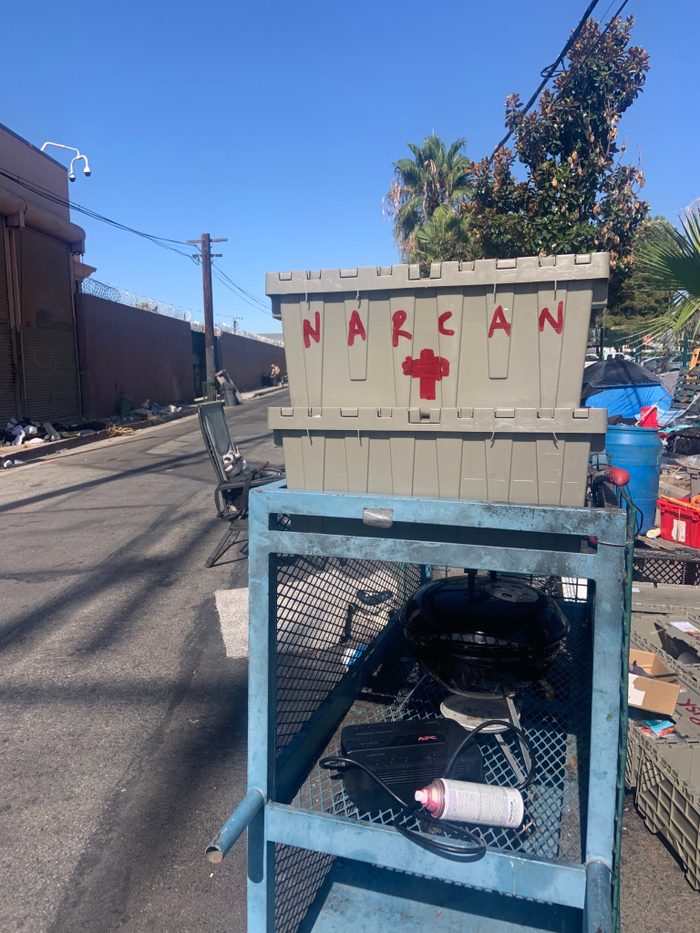
“I don’t understand how we can pick up our stuff when we’ve seen it go inside of a [garbage compactor] and be crushed,” says La Donna Harrell, another former resident of the Aetna Street encampment who witnessed city workers destroying Narcan.
Gomez says the city follows “established protocols for the removal and storage of items gathered during cleanups” and that crews store property collected during sweeps — including naloxone — at different sites across the city.
Signs posted prominently at the sites of many sweeps throughout Los Angeles say that “Items collected by the city may be retrieved from or by contacting the following location: The BIN” on Towne Avenue in Skid Row, a warehouse preceded by a tall black gate with razor wire.
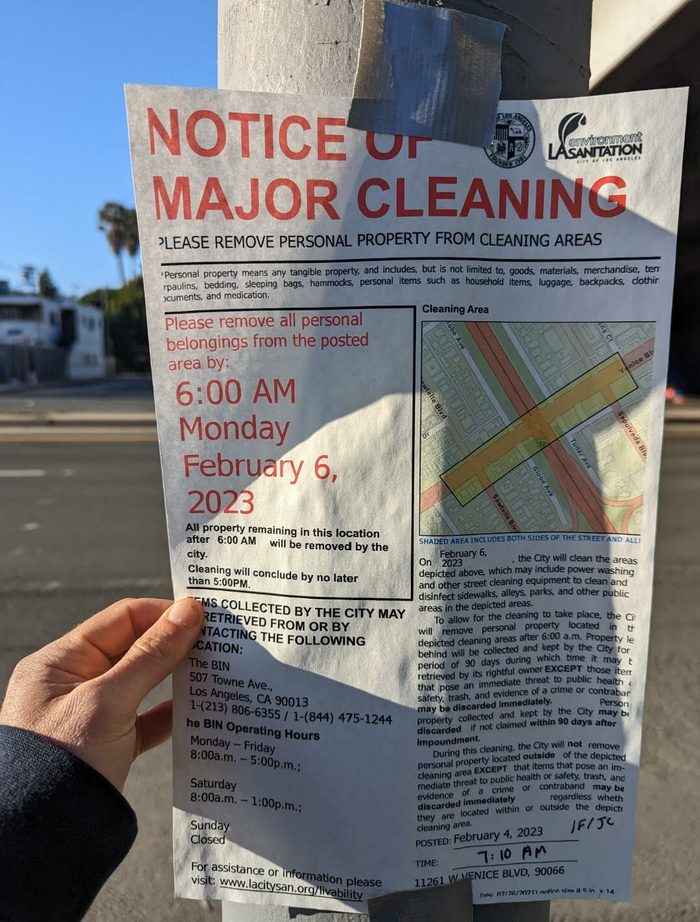
But an employee working at the front desk of The BIN said he had “never” seen Narcan delivered or stored there.
“That kind of stuff, they wouldn’t bring here — they would just discard it,” said the employee, who declined to give his full name but noted he was familiar with naloxone. “They would trash it … they don’t bring it to us.”
The employee later reported that he had searched for records regarding several encampment sweeps where residents told harm-reduction volunteers that they had lost naloxone — and could not find any “paperwork on that whatsoever.”
“So they have to have trashed it, just want you to know,” the employee said.
Meanwhile, the city is still litigating the 2019 lawsuit, Garcia v. City of Los Angeles, that alleges city sanitation crews destroy property collected from sweeps instead of storing the property.
“In general, we almost never hear about anyone getting their property back,” says Mike Dickerson, policy and education co-chair for the homelessness outreach group KTown For All, which is a plaintiff in the Garcia case. In the fourth quarter of 2018 alone, the city swept more than 2,200 encampments, according to the lawsuit, and trashed three tons of debris for every bag of property collected.
Narcan is available over the counter, but a single box often costs between about $50 and $150, which is a significant barrier for low-wealth people to purchase it at all, let alone in bulk.
The naloxone found in encampments has typically been purchased with state funds, Snakeoil says. The state’s Naloxone Distribution Project (NDP) has received approximately $325 million since 2018, according to the California Department of Health Care Services, and distributed nearly 3.7 million kits of naloxone. The state has also spent an additional $45 million providing funds for harm-reduction clinics since 2020.
In an email to In These Times, state Department of Health Care Services spokesperson Anthony Cava wrote that “the NDP’s total budget (allocated) was $70,003,000 for 2022-23 and $150,295,408 for 2023-24.” However, of that roughly $150 million, Cava notes that only about $71.5 million was projected to be spent. (Cava also noted that, historically, harm-reduction organizations like The Sidewalk Project make up a small percentage of the applications for naloxone from the NDP but are responsible for more than half of all overdose reversals reported to the state agency.)
“This is kind of like a snake eating itself because these supplies are funded by the state of California,” Snakeoil says. “Then local jurisdictions are just sweeping through thousands and thousands and thousands of dollars that our taxpayer money has gone to.”
“We distribute the stuff, and they confiscate the stuff. It’s very strange,” she says. “It’s counterproductive.”
Narcan is the brand name for a nasal spray version of the medicine called naloxone, which was first submitted for patent in 1961 by doctors Jack Fishman and Mozes Lewenstein. It binds to opioid receptors in the brain, blocking opioids from binding there and restoring breathing to the body. The medicine comes in a few different forms, with the nasal spray (and the Narcan brand) being the most common.
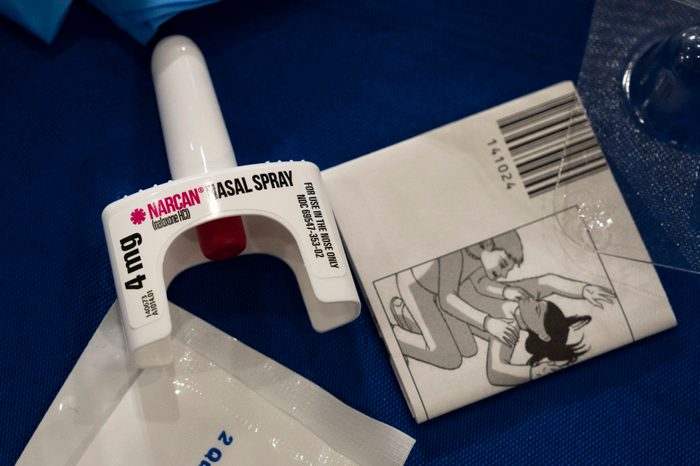
Naloxone is described as a miracle drug that can do what pretty much nothing else can do: stop someone from dying of a fentanyl overdose at a time when such deaths continue to relentlessly increase.
Los Angeles has swept encampments of unhoused populations for more than a century, even rounding up unhoused men into chain gangs that graded and paved roads in the late 1800s and early 1900s. Today, encampment sweeps in LA are run under its Comprehensive Cleaning and Rapid Engagement (CARE) program, which was launched in 2019. Then-city council president Nury Martinez, in characterizing the program, said the city had “to restore order in our streets,” arguing that encampments had taken over parks and sidewalks.
Since 2021, lawmakers have also blanketed the city with zones where it is illegal to sit, sleep, lie down or store property in the public right-of-way. The Aetna Street encampment, where Hams once lived, is in one such zone.
When sanitation crews repeatedly swept Aetna Street in September 2023, organizers and residents say they didn’t just destroy the Narcan in the community “Medicine Cabinet,” they also destroyed the Narcan that had been included in a memorial to Terry Mason Kendrick, a resident who one community organizer says had died just weeks earlier of a stroke and subsequent heart attack. Kendrick was passionate about distributing Narcan and other forms of naloxone, says Aetna Street Solidarity organizer Carla Orendorff.
“We will never forget you, or forgive you for dying,” someone had written as part of the memorial beneath a photograph of Kendrick flipping off the camera. “Rest in peace, you son of a bitch.”
Video taken by another organizer, Paisley Mares, shows the memorial — along with the Narcan — dumped in a garbage truck during a sweep on September 21, 2023.
The multi-block Aetna Street encampment was once organized and vibrant. Residents threw a street fair called Aetnapalooza with street vendors, free haircuts, mural painting, musicians and dancing. They held karaoke nights, contributed to the newspaper Street Views, and some residents and organizers even met with LA Mayor Karen Bass alongside other unhoused people who had been placed in motels through Bass’ signature Inside Safe program. The group called itself the Inside Starving coalition because some residents alleged that they weren’t being adequately fed in the motels. The mayor was told at the meeting that that many of the motel rooms were bug-ridden and that residents didn’t have mental health services. (A spokesperson for the mayor told LAist that “many of the issues raised [by the Inside Starving coalition] are serious institutional problems that have long plagued housing efforts in Los Angeles,” but did not otherwise address residents’ complaints. Bass also told KCRW that it is a “struggle” for the city to immediately provide services to unhoused people in the program “because the social service providers that do that work are stretched to capacity, as well.”)
A couple of days before the first sweep of the Aetna Street encampment, a massive team of city employees, homelessness caseworkers and police tried to move Aetna residents into motels through the Inside Safe program. But a handful of residents, wary of reported conditions in the program, didn’t want to leave, according to Orendorff. A video shows residents of the encampment being told that they would not lose their belongings if they continued to stay on Aetna Street.
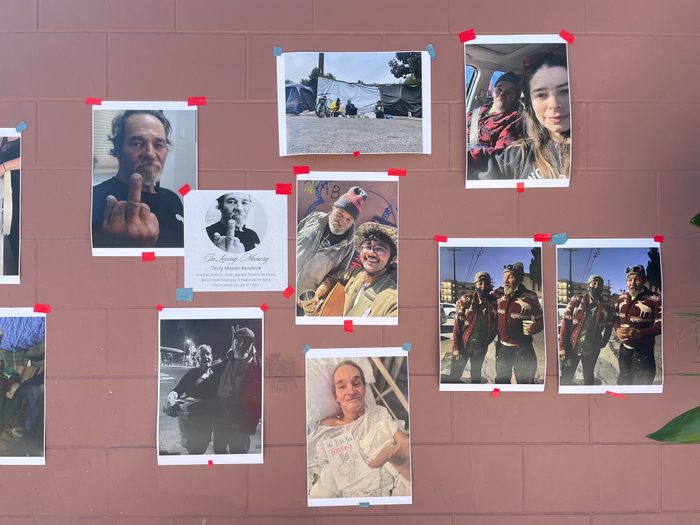
Two days later, sanitation workers and police officers arrived to sweep the remaining tents. Councilmember Imelda Padilla, whose district includes Aetna Street, was initially present, according to pictures and a video taken by organizers. Hams and Harrell say sanitation workers gave them less than 15 minutes to collect their belongings and move out of the area (standard practice for sweeps in Los Angeles). Chaos ensued as residents tried to haul their tents and belongings away as fast as they could.
Hams says there was such a rush to collect belongings that he didn’t have a chance to save “The Medicine Cabinet” with the naloxone. Most anything left in a clean-up zone after the 15 minutes is destroyed, according to unhoused people interviewed for this article, though the city claims that non-hazardous and non-criminal property is stored and can be retrieved.
Those are the guidelines set out by Lavan v. City of Los Angeles, a case that found the city was destroying the property of unhoused people in Skid Row in violation of the 4th and 14th Amendments.
But some unhoused residents like La Donna Harrell say the city is still indiscriminately trashing property left behind in sweeps.
“You could have the ashes of your dead mother [in the clean-up zone], and they wouldn’t let you get it,” says Harrell. She says she watched the naloxone get crushed in a garbage truck.
Padilla did not respond to a request for comment about the naloxone destroyed in the Aetna Street sweep. A spokesperson for Bass said “the mayor’s office and Inside Safe teams did not dispose of the naloxone that you asked about and have no knowledge of it.”
Harrell decries that, in addition to the naloxone, she lost “everything” in the sweep including, critically, her photo ID.
Naloxone is not necessarily “the first thing that I grab,” she says. “Because I have to grab other stuff. But it’s like, dang, you know? That’s gonna be useful when someone goes out — like someone went out yesterday.”
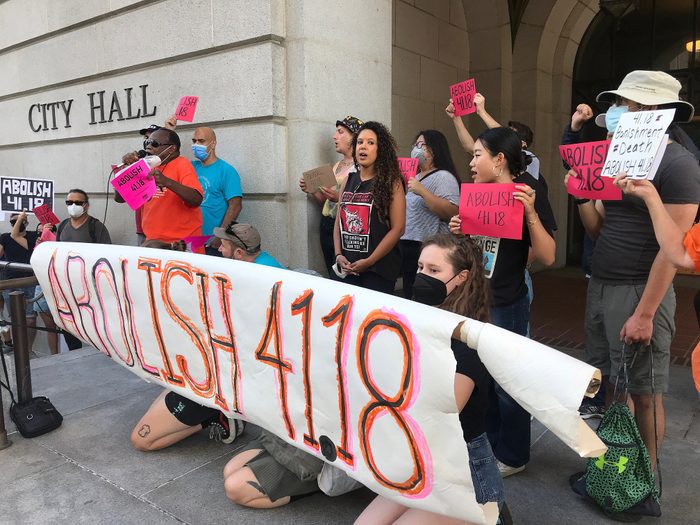
Sweeps are notorious for destroying vital belongings and naloxone is no exception, says researcher Goldshear. Additional research published on sweeps by Goldshear and others found the practice may “substantially” increase mortality rates among unhoused people.
A spokesperson for Los Angeles County wrote in an email to In These Times “that involuntary sweeps of people experiencing homelessness are a harmful and ineffective strategy to resolve homelessness.”
“The County is aware of research that has found that involuntary encampment displacements of people experiencing homelessness can result in the loss of important personal belongings, such as naloxone,” the spokesperson wrote.
When CHPLA’s Cowan gets an especially large order for naloxone from a mutual aid group, she suspects there may have been a major sweep of an encampment somewhere in the city. That’s what happened several years ago — during the height of a nationwide shortage of the drug — when a mutual aid group in the San Pedro area asked for naloxone in “quantities they hadn’t asked for before.”
“There had been, in that case, a particularly brutal sweep in the South Bay, where hundreds of doses had been lost,” she recalls.
Matthew Katz, a harm-reduction volunteer who distributes naloxone with Palms Unhoused Mutual Aid in West LA, says he watched sanitation workers, during a sweep in spring 2023, also pull naloxone. It happened right in front of him.
“You could see that as people were moving their stuff, Narcan was falling out,” he says. “And sanitation comes and they sweep it up.”
On top of California’s most recent $71.5 million investment in the Naloxone Distribution Project, the state will spend an additional $61 million to help fund harm-reduction clinics over the next four years with money won in lawsuits against pharmaceutical corporations for their role in the opioid crisis.
“California is doubling down to combat this crisis and save lives,” Newsom said in spring 2023 when announcing a plan to fight the opioid crisis. In July 2023, he launched an initiative for the state to produce its own brand of naloxone. “One more fatal overdose is one too many,” he said in a statement.
But in January 2023, Newsom also pledged to spend $750 million clearing encampments, dwarfing the state’s investment in naloxone distribution. “People want to see these encampments cleaned up,” Newsom said. “They’re fed up.”
The California Budget & Policy Center, however, does not share Newsom’s enthusiasm for sweeps. “Our concern is that solely clearing the streets without addressing the root cause will displace individuals without providing sustainable solutions,” wrote a spokesperson for the nonprofit organization.
LA City Councilmember Hugo Soto-Martínez was the only elected official of about 20 across the state who issued a response to questions from In These Times about the sweeps and naloxone. Soto-Martínez said in a statement that sweeps do not solve homelessness and that unhoused people often lose “documents like IDs” and “life-saving medications like prescriptions or Narcan” in the clearances.
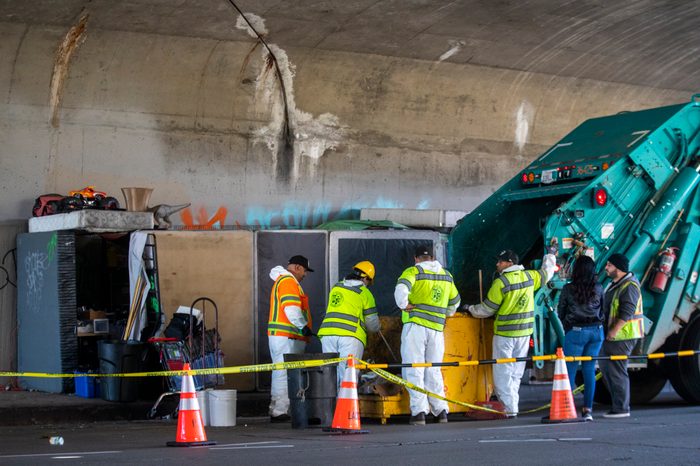
Newsom’s office referred questions about naloxone and sweeps to Caltrans, which also conducts some encampment sweeps. A Caltrans spokesperson indicated that the agency posts notices of sweeps 48 hours in advance — but not always — and wrote that the agency “works diligently to label and collect personal belongings left behind at encampments.” But the spokesperson did not respond to questions about naloxone.
From a casual perspective, it would seem ironic that Newsom, a Democrat, has lobbied for the Supreme Court to overturn 9th Circuit restrictions on sweeps — and that irony isn’t lost on him.
“I hope this goes to the Supreme Court,” Newsom said in September 2023, “and that’s a hell of a statement coming from a progressive Democrat.”
In November 2022, then-LA City Attorney Mike Feuer sat in the rooftop bar of the W Hollywood hotel, fending off accusations from members of the local Business Improvement District that he was soft on homelessness.
The audience, a smattering of luxury developers and Walk of Fame landlords, grew agitated as Feuer slalomed between conservative and progressive talking points.
Feuer said he had tried to find loopholes in the repeated court injunctions limiting sweeps, even taking a health expert to Skid Row to identify hazardous objects that could be cleared under the Lavan decision’s “health and safety” exception. Ninth Circuit rulings had prevented the city from indiscriminately taking property and from sweeping encampments if it couldn’t offer residents’ shelter beds, but “we could [still] do cleanings, we could pick up bulky items, we could say you can’t be next to this fire hydrant, all kinds of stuff,” Feuer said.
Then he cast sweeps as cruel. “Sure, you can’t say to somebody, ‘You have no place to go, but get off the sidewalk.’ None of you wants us to live in a world like that, right?”
Publicly funded sweeps trashing publicly funded naloxone may sound contradictory — if not foolish. But for decades in Los Angeles, lawmakers have answered the demand from unhoused advocates for “services not sweeps” with services and sweeps, insisting the contrasting approaches can be reasonably paired. Organizers say the result is a ridiculous — and deadly — cocktail of violent policing and sporadic, often unproductive attempts to provide aid.
Aetna Street organizer Orendorff says that the services and shelters offered by the city seem to often just provide public relations cover for the brutality of the sweeps. In 2019, when LA tried to reform its sweeps under the CARE program, it began sending a mobile shower with the garbage trucks. The result is that now, Orendoff says, some unhoused people worry a sweep is coming when they see a mobile shower.
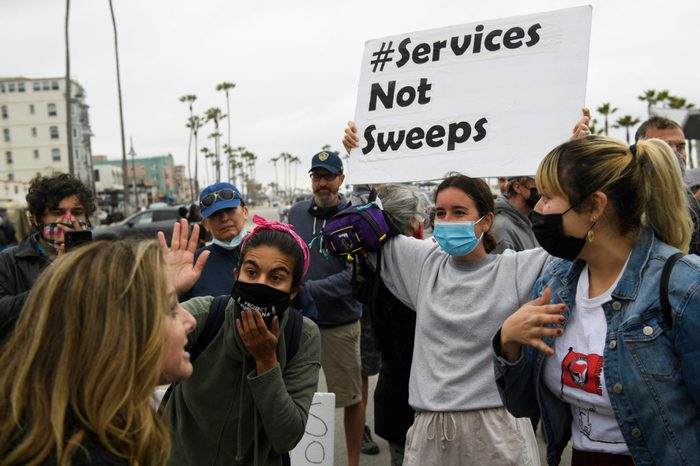
As lawmakers wrestle with the fentanyl crisis, Cowan of the CHPLA says that harm reduction and policing “fundamentally contradict each other.”
The point of harm reduction, Snakeoil argues, should be to place supplies in the hands of drug users because they are best positioned to save the lives of other drug users. Sweeps and policing, however, separate unhoused people from service providers as well as unhoused people from each other, according to interviews with unhoused people, advocates and research from Santa Clara University and UC Berkeley which found encampments form specifically because of their proximity to service providers.
Ndindi Kitonga of Palms Unhoused Mutual Aid distributes Narcan at motels that are part of Inside Safe because, she says, there is not enough naloxone there and participants are frequently unable to visit each other. A city contract laying out Inside Safe policies for the Mayfair Hotel in Westlake, for example, stipulates that residents are not allowed to have visitors or visit each other’s rooms. (A spokesperson for the mayor’s office wrote in an email to In These Times that participants in the Inside Safe program “can bring belongings, including naloxone, with them” and that providers there “are trained in naloxone administration.”)
Harrell, who has since been moved into a motel through Inside Safe, argues that any rules around visitation could make fatal overdoses more likely. “[Fentanyl] is one drug that people should not do alone,” Harrell says. “You cannot Narcan yourself.”
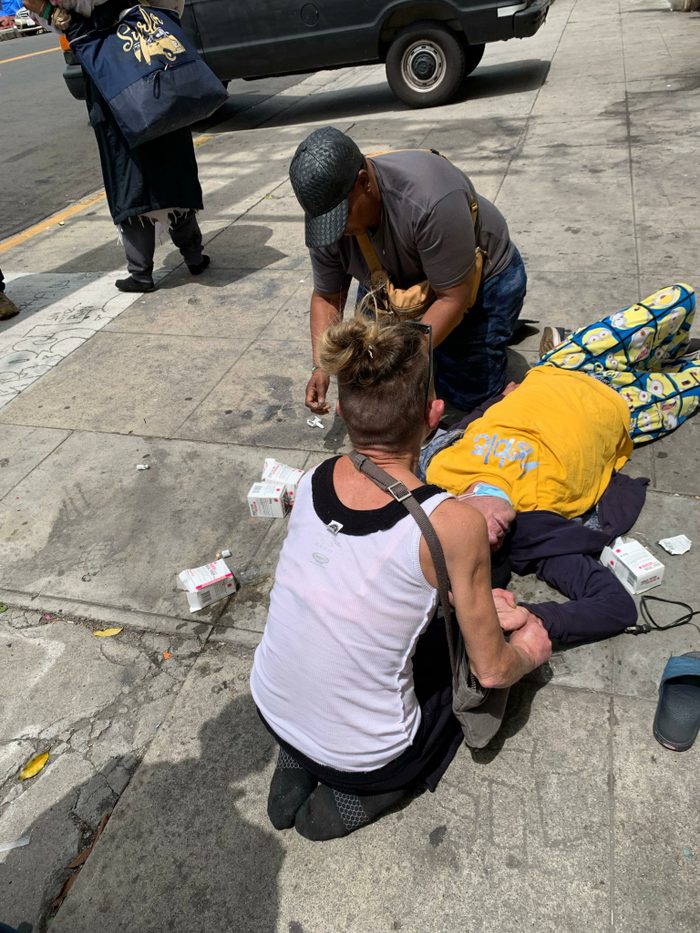
At The Sidewalk Project on Skid Row, an unhoused woman known on the street as Bella (who declined to give her real, full name because she wanted to make sure she was not vulnerable to any attack) says she uses naloxone to reverse one of her neighbors’ overdoses “at least once a month.”
We’re talking in one room with executive director Snakeoil — who realizes that someone whose life Bella saved is actually on the other side of the office door.
I find him in the common area. He’s upbeat, eating strawberry Pocky sticks on one of The Sidewalk Project couches, talking about the incident like someone who slept through a plane crash and walked away without a cut.
Snakeoil shares a photo of Bella reviving him.
In the image, she’s half his size, her gaunt frame arching over his body on the sidewalk as she brings him back to life.
Thomas Birmingham contributed to this article.
Jack Ross is a journalist in Los Angeles.








